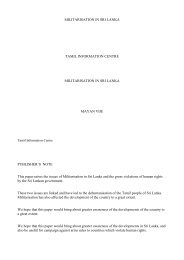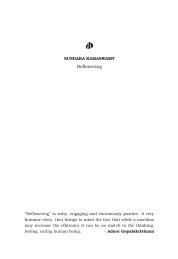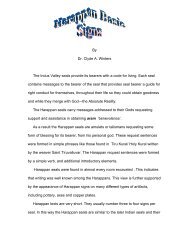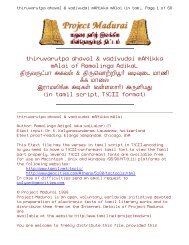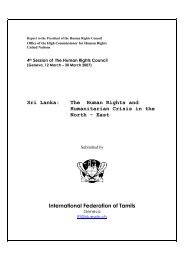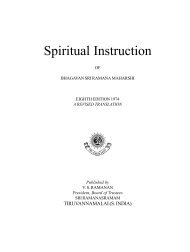Asymmetric Warfare And Low Intensity Maritime Operations
Asymmetric Warfare And Low Intensity Maritime Operations
Asymmetric Warfare And Low Intensity Maritime Operations
- No tags were found...
Create successful ePaper yourself
Turn your PDF publications into a flip-book with our unique Google optimized e-Paper software.
ORF Occasional Paper<strong>Asymmetric</strong> <strong>Warfare</strong> <strong>And</strong> LIMO: Challenges For Indian Navydeliberation/ augmentation in support of LIMO are:● A balanced naval force for blue water operations as also for swift and deadly responseto threats closer home.● UAV/UCAV in support of LIMO.● Augmentation of Special Forces.● Examine the use of the capabilities of mammals/birds, their extraordinary senses,swimming or flying ability.● Harness off-the-shelf technologies to support LIMO.● Improving intelligence networks.● Building database of terrorist organisations, drug cartels and gun-runners.● <strong>Maritime</strong> cooperation with littorals and sharing of intelligence.● Joint operations in support of LIMO.● Develop common communication and operational doctrines.ABOUT THE AUTHORDr Vijay Sakhuja is a former Indian Navy officer and currently Senior Fellow at Observer Research Foundation,New Delhi. He received his Doctorate in <strong>Maritime</strong> Security from the Jawaharlal Nehru University,New Delhi. Earlier, he completed his MPhil studies in Arms Control and Disarmament from the same university.He was Research Fellow at the Institute for Defence Studies and Analyses, New Delhi, and UnitedServices Institution of India, New Delhi. He has authored a book, Confidence Building From The Sea: AnIndian Initiative, and is the recipient of Vice Admiral S L Sethi <strong>Maritime</strong> Media Award, 2002. His researchareas include <strong>Maritime</strong> security, Naval Developments and Risk Analysis of Critical Infrastructure andGlobal Supply Chains.References1. Sun Tzu, The Art of War, ( New York: Dell Publishing,1983), p.34, cited in Robert L. Pfaltzgraff Jr. andStephen E. Wright, “The Spectrum of Conflict: Symmetrical or <strong>Asymmetric</strong>al Challenges?” in ed.Richard H. Shultz Jr. and Robert L. Pfaltzgraff Jr., The Role of Naval Forces in 21st Century <strong>Operations</strong>,pp.12-13.2. Ibid.3. “<strong>Asymmetric</strong> <strong>Warfare</strong>, The USS Cole and the Intifada”, The Estimate, Volume12, Number 22,November3,2001.4. Robert L. Pfaltzgraff Jr. and Stephen E. Wright, N.1. pp.12-13.5. Ibid.6. Ibid.7. This is the classic definition of “asymmetry” by the US National Defense University’s Institute forNational Strategic Studies in their 1998 Strategic Assessment available at .8. Robert L. Pfaltzgraff Jr. and Stephen E. Wright, in ed. Richard H. Shultz Jr. and Robert L. Pfaltzgraff Jr.,The Role of Naval Forces in 21st Century <strong>Operations</strong>, p.20.9. Al Qaeda attack on USS Cole, Tamil Sea Tigers attack on Sri Lanka naval ship and the attempted Hamasattack on Israeli naval craft10. See ‘Worries Grow Over Tankers’ Vulnerability to Attack’ at http://www.planetark.org. Accordingto Tatsuo Masuda, President of the Asia Pacific Energy Research Centre, the Strait of Hormuz in theMiddle East and Strait of Malacca in South East Asia, are heavily used by tankers.11. Ibid.12. Ibid.13. Edward Hanlon Jr, ‘ Taking the Long View: Littoral <strong>Warfare</strong> Challenges’ in ed. Richard H. Shultz Jr. andRobert L. Pfaltzgraff Jr., The Role of Naval Forces in 21st Century <strong>Operations</strong>, p.156.14. A mystery ship, reportedly controlled by the LTTE was spotted 100 nm north east of Mullaitivu andoffloaded weapons to small boats before the crew noticed they were being watched by Indian forcesand began dumping items overboard. Sri Lankan naval forces are reported to have intercepted onNovember 1, 2002, off Trincomalee , a dingy with six armed LTTE and communications equipment.The 6 men were brought to Trincomalee and handed over to police along with the communicationsequipment. Although truce talks are ongoing, the incident illustrates Sri Lanka’s continued effort toprevent rebel re-supply or surprise attack. Reportedly, navies of Sri Lanka and India have agreed arange of measures to step up surveillance to prevent LTTE arms smuggling across the narrow northernstrait separating the two countries. For details see ONI WorldWide Threat to Shipping reports dated 27December 2002 and January 01, 2003 at .15. A recent Time Magazine report has noted that Bangladesh is “hotbed of radical Islam”.Reportedly, 150 men belonging to “Taliban and Al-Qaeda fighters from Afghanistan had enteredBangladesh through Chittagong harbour in December 2001. They arrived by MV Mecca, and wereseen carrying boxes of ammunition and AK-47 assault rifles. Harkat-ul-Jihad-al-Islami (HUJI) ofBangladesh, a force of about 2,000 men is closely linked with the Al Qaeda. Bangaladesh ForeignSecretary Shamsher Mobin Chowdhury rejected the Time article as baseless. Earlier in April 2001, theFar Eastern Economic Review ran a cover story depicting Bangladesh a ‘cocoon of terror’ - a havenof Islamic fundamentalist terrorists. The LTTE gun trade route passes through the Bay of Bengal and<strong>And</strong>aman Sea . Arms originating from Cambodia are loaded onboard small fishing trawlers in thesouthern Thailand port of Ranong. These vessels then transfer the consignment to larger vessels at seafor onward passage to Sri Lanka. Some of these weapons are transported by small boats to Cox Bazarin Bangladesh . Several vessels engaged in gun-running have been captured in the region. In 1996,Bangladesh authorities seized 600 rifles onboard a fishing trawler originating in Thailand. In 1997,the Royal Thai Navy seized an arms shipment for the People’s Liberation Army ( Manipur) following achase in the <strong>And</strong>aman Sea off the port of Ranong. From 1984 to 1990 , a Malaysian island was used bythe LTTE to train its Sea Tiger personnel. Gun-running by ships is by far the safest method.23www.orfonline.orgwww.orfonline.org 24



